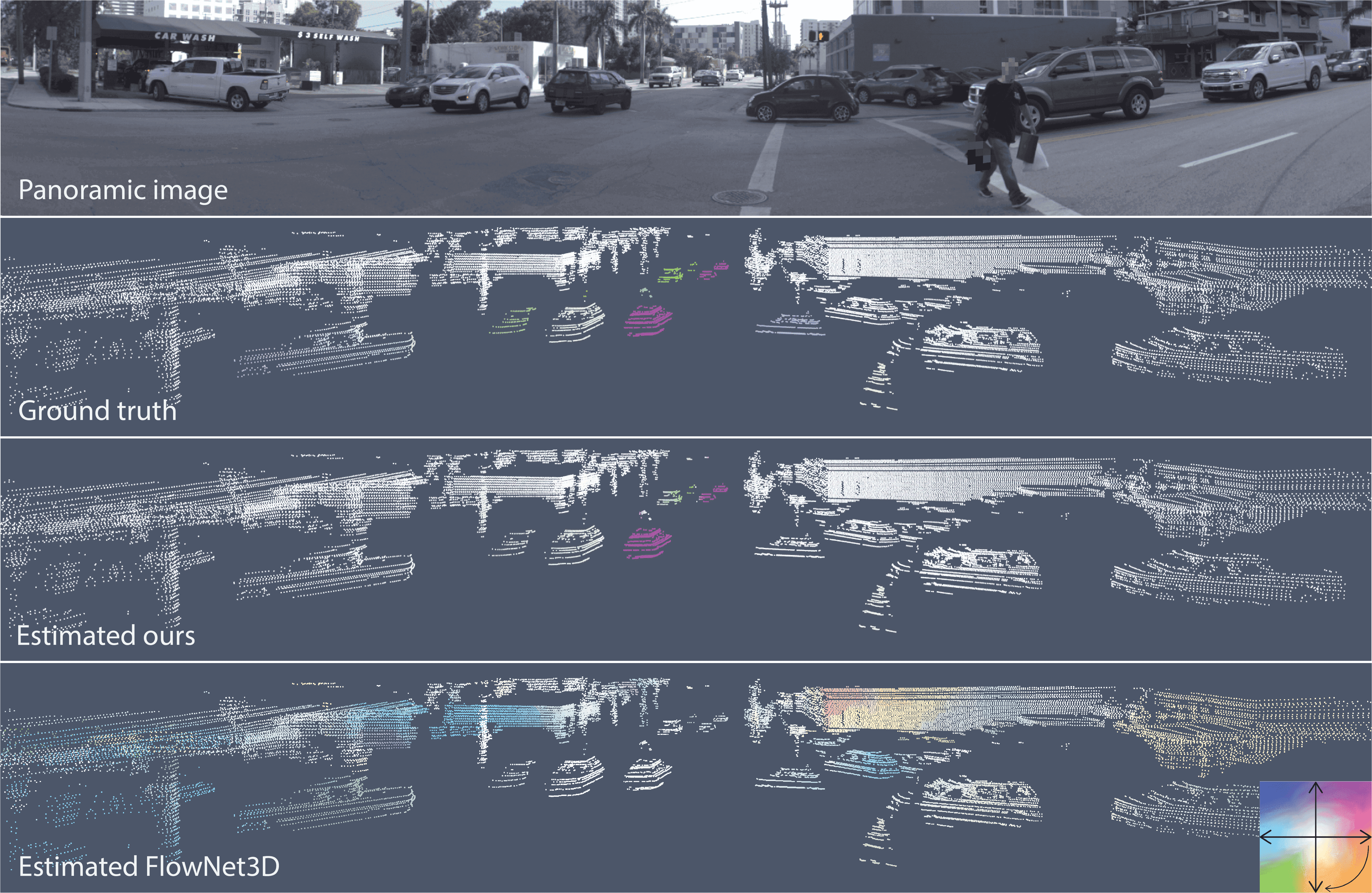Xueqian Li, Jhony Kaesemodel Pontes, Simon Lucey
Thirty-fifth Conference on Neural Information Processing Systems (NeurIPS, 2021), Spotlight presentation.
Project page: https://lilac-lee.github.io/Neural_Scene_Flow_Prior/.
arXiv link: https://arxiv.org/pdf/2111.01253.pdf.
-
We have a new project that makes the runtime optimization of the neural scene flow prior faster, achieving near real-time performance compared to learning-based methods. Please check out the code at FastNSF.
-
The code for preprocessing the dataset to get the pseudo scene flow is released! You can find it in preprocess_sf_argoverse.py and preprocess_sf_nuscenes.py.
This code is based on PyTorch implementation, and tested on torch=1.6.0 with CUDA 10.1 OR torch=1.7.1 with CUDA 10.2.
For a detailed installation guide, please go to requirements.txt.
We provide four datasets we used in our paper. You may download datasets used in the paper from these anonymous links:
-
KITTI (266MB)
-
Argoverse (370MB)
-
nuScenes (73MB)
-
FlyingThings3D (948MB)
After you download the dataset, you can create a symbolic link in the ./dataset folder as ./dataset/kitti, ./dataset/argoverse, ./dataset/nuscenes, and ./dataset/flyingthings.
Since we use neural scene flow prior for runtime optimization, our method does not include any "training".
Just run following lines for a simple optimization on a small KITTI Scene Flow dataset (only 50 testing samples)
python optimization.py \
--dataset KITTISceneFlowDataset \
--dataset_path dataset/kitti \
--exp_name KITTI_2048_points \
--batch_size 1 \
--iters 5000 \
--compute_metrics \
--num_points 2048 \
--hidden_units 128 \
--lr 0.008 \
--backward_flow \
--early_patience 70 \
--visualize
You can then play with these configurations. We provide commands we used to generate results in the small point coud (2048 points) experiments and large point cloud (all points included) experiments.
python optimization.py \
--dataset KITTISceneFlowDataset \
--dataset_path dataset/kitti \
--exp_name KITTI_2048_points \
--batch_size 1 \
--iters 5000 \
--compute_metrics \
--num_points 2048 \
--hidden_units 128 \
--lr 0.008 \
--backward_flow \
--early_patience 70 \
--visualize
python optimization.py \
--dataset ArgoverseSceneFlowDataset \
--dataset_path dataset/argoverse \
--exp_name Argoverse_2048_points \
--batch_size 1 \
--iters 5000 \
--compute_metrics \
--num_points 2048 \
--hidden_units 128 \
--lr 0.008 \
--backward_flow \
--early_patience 30 \
--visualize
python optimization.py \
--dataset NuScenesSceneFlowDataset \
--dataset_path dataset/nuscenes \
--exp_name Argoverse_2048_points \
--batch_size 1 \
--iters 5000 \
--compute_metrics \
--num_points 2048 \
--hidden_units 128 \
--lr 0.008 \
--backward_flow \
--early_patience 30 \
--visualize
python optimization.py \
--dataset FlyingThings3D \
--dataset_path dataset/flyingthings \
--exp_name FlyingThings_2048_points \
--batch_size 1 \
--iters 5000 \
--compute_metrics \
--num_points 2048 \
--hidden_units 128 \
--lr 0.008 \
--backward_flow \
--early_patience 30 \
--visualize
python optimization.py \
--dataset KITTISceneFlowDataset \
--dataset_path dataset/kitti \
--exp_name KITTI_2048_points \
--batch_size 1 \
--iters 5000 \
--compute_metrics \
--use_all_points \
--hidden_units 128 \
--lr 0.001 \
--early_patience 100 \
--visualize
python optimization.py \
--dataset ArgoverseSceneFlowDataset \
--dataset_path dataset/argoverse \
--exp_name Argoverse_2048_points \
--batch_size 1 \
--iters 5000 \
--compute_metrics \
--use_all_points \
--hidden_units 128 \
--lr 0.003 \
--backward_flow \
--early_patience 100 \
--visualize
If you find the project useful for your research, you may cite,
@article{li2021neural,
title={Neural Scene Flow Prior},
author={Li, Xueqian and Kaesemodel Pontes, Jhony and Lucey, Simon},
journal={Advances in Neural Information Processing Systems},
volume={34},
year={2021}
}


